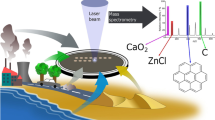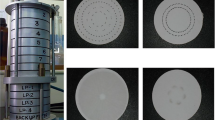Abstract
To achieve unattended continuous long-term (eg., 1 week) sampling of size-segregated 24-h ambient particulate matter (PM), a sampling strategy of a modified 3-stage rotating drum impactor (RDI) in series with a sequential filter sampler was introduced and verified in a field campaign. Before the field sampling, lab experiment was conducted to test the collection efficiency of the third stage of the RDI using the quartz-fiber filter (QFF) as the substrate. The measured value is 0.36 μm, which is larger than the nominal value 0.1 μm. A fast direct analysis of organic species in all size fractions (<0.36, 0.36–1, 1–2.4, and 2.4–10 μm) of 24-h ambient samples was done using in situ derivatization thermal desorption gas chromatography time-of-flight mass spectrometry (IDTD-GC-TOFMS). A few secondary originated polar markers (dicarboxylic acids, cis-pinonic acid, etc.) were introduced and evaluated using this method for the first time and quantified simultaneously with polycyclic aromatic hydrocarbons (PAH) in the filter samples (<0.36 μm). For the other RDI strip samples (0.36–1, 1–2.4, and 2.4–10 μm), PAH and levoglucosan were quantified. The comparability of two such sampler sets was verified with respect to the PM collection profile of the two RDIs as well as measured concentration of chemical compounds in each sampled size fraction, so that a future epidemiological study on the relationship between the finest PM/its chemical composition and health outcome could be carried out through parallel sampling at two sites. The internal correlations between the size-segregated organic compounds are discussed. Besides, the correlations between the size-segregated organic species and size-segregated particulate number concentration (PNC) as well as meteorological parameter are discussed as well.





Similar content being viewed by others
References
Agarwal S, Aggarwal SG, Okuzawa K, Kawamura K (2010) Size distributions of dicarboxylic acids, ketoacids, alpha-dicarbonyls, sugars, WSOC, OC, EC and inorganic ions in atmospheric particles over Northern Japan: implication for long-range transport of Siberian biomass burning and East Asian polluted aerosols. Atmos Chem Phys 10:5839–5858
Albinet A, Leoz-Garziandia E, Budzinski H, Villenave E, Jaffrezo JL (2008) Nitrated and oxygenated derivatives of polycyclic aromatic hydrocarbons in the ambient air of two French alpine valleys—Part 2: particle size distribution. Atmos Environ 42:55–64
Allen JO, Dookeran KM, Smith KA, Sarofim AF, Taghizadeh K, Lafleur AL (1996) Measurement of polycyclic aromatic hydrocarbons associated with size-segregated atmospheric aerosols in Massachusetts. Environ Sci Technol 30:1023–1031
Bukowiecki N, Hill M, Gehrig R, Zwicky CN, Lienemann P, Hegedus F, Falkenberg G, Weingartner E, Baltensperger U (2005) Trace metals in ambient air: hourly size-segregated mass concentrations determined by Synchrotron-XRF. Environ Sci Technol 39:5754–5762
Bukowiecki N, Gehrig R, Hill M, Lienemann P, Zwicky CN, Buchmann B, Weingartner E, Baltensperger U (2007) Iron, manganese and copper emitted by cargo and passenger trains in Zurich (Switzerland): size-segregated mass concentrations in ambient air. Atmos Environ 41:878–889
Bukowiecki N, Richard A, Furger M, Weingartner E, Aguirre M, Huthwelker T, Lienemann P, Gehrig R, Baltensperger U (2009) Deposition uniformity and particle size distribution of ambient aerosol collected with a rotating drum impactor. Aerosol Sci Technol 43:891–901
Claeys M, Graham B, Vas G, Wang W, Vermeylen R, Pashynska V, Cafmeyer J, Guyon P, Andreae MO, Artaxo P, Maenhaut W (2004) Formation of secondary organic aerosols through photooxidation of isoprene. Science 303:1173–1176
Claeys M, Kourtchev I, Pashynska V, Vas G, Vermeylen R, Wang W, Cafmeyer J, Chi X, Artaxo P, Andreae MO, Maenhaut W (2010) Polar organic marker compounds in atmospheric aerosols during the LBA-SMOCC 2002 biomass burning experiment in Rondonia, Brazil: sources and source processes, time series, diel variations and size distributions. Atmos Chem Phys 10:9319–9331
Demokritou P, Lee SJ, Ferguson ST, Koutrakis P (2004) A compact multistage (cascade) impactor for the characterization of atmospheric’ aerosols. J Aerosol Sci 35:281–299
Di Filippo P, Riccardi C, Pomata D, Buiarelli F (2010) Concentrations of PAHs, and nitro- and methyl-derivatives associated with a size-segregated urban aerosol. Atmos Environ 44:2742–2749
Gu J, Pitz M, Schnelle-Kreis J, Diemer J, Reller A, Zimmermann R, Soentgen J, Stoelzel M, Wichmann HE, Peters A, Cyrys J (2011) Source apportionment of ambient particles: comparison of positive matrix factorization analysis applied to particle size distribution and chemical composition data. Atmos Environ 45:1849–1857
Hermann M, Wiedensohler A (2001) Counting efficiency of condensation particle counters at low-pressures with illustrative data from the upper troposphere. J Aerosol Sci 32:975–991
Kavouras IG, Koutrakis P (2001) Use of polyurethane foam as the impaction substrate/collection medium in conventional inertial impactors. Aerosol Sci Technol 34:46–56
Kelly FJ, Fussell JC (2012) Size, source and chemical composition as determinants of toxicity attributable to ambient particulate matter. Atmos Environ 60:504–526
Lee SJ, Demokritou P, Koutrakis P (2005) Performance evaluation of commonly used impaction substrates under various loading conditions. J Aerosol Sci 36:881–895
Lundgren DA (1967) An aerosol sampler for determination of particle concentration as a function of size and time. J Air Pollut Control Assoc 17:225–229
Marple VA (2004) History of impactors—the first 110 years. Aerosol Sci Technol 38:247–292
Marple VA, Willeke K (1976) Impactor design. Atmopheric Environ 10:891–896
Orasche J, Schnelle-Kreis J, Abbaszade G, Zimmermann R (2011) Technical note: in-situ derivatization thermal desorption GC-TOFMS for direct analysis of particle-bound non-polar and polar organic species. Atmos Chem Phys 11:8977–8993
Park SS, Kim YJ, Kang CH (2007) Polycyclic aromatic hydrocarbons in bulk PM2.5 and size-segregated aerosol particle samples measured in an urban environment. Environ Monit Assess 128:231–240
Pitz M, Cyrys J, Karg E, Wiedensohler A, Wichmann HE, Heinrich J (2003) Variability of apparent particle density of an urban aerosol. Environ Sci Technol 37:4336–4342
Pitz M, Birmili W, Schmid O, Peters A, Wichmann HE, Cyrys J (2008a) Quality control and quality assurance for particle size distribution measurements at an urban monitoring station in Augsburg, Germany. J Environ Monit 10:1017–1024
Pitz M, Schmid O, Heinrich J, Birmili W, Maguhn J, Zimmermann R, Wichmann HE, Peters A, Cyrys J (2008b) Seasonal and diurnal variation of PM(2.5) apparent particle density in urban air in Augsburg, Germany. Environ Sci Technol 42:5087–5093
Rao AK, Whitby KT (1978) Non-ideal collection characteristics of inertial impactors—II. Cascade impactors. J Aerosol Sci 9:87–100
Richard A, Bukowiecki N, Lienemann P, Furger M, Fierz M, Minguillon MC, Weideli B, Figi R, Flechsig U, Appel K, Prevot ASH, Baltensperger U (2010) Quantitative sampling and analysis of trace elements in atmospheric aerosols: impactor characterization and Synchrotron-XRF mass calibration. Atmos Meas Tech 3:1473–1485
Richard A, Gianini MFD, Mohr C, Furger M, Bukowiecki N, Minguillon MC, Lienemann P, Flechsig U, Appel K, DeCarlo PF, Heringa MF, Chirico R, Baltensperger U, Prevot ASH (2011) Source apportionment of size and time resolved trace elements and organic aerosols from an urban courtyard site in Switzerland. Atmos Chem Phys 11:8945–8963
Rogula-Kozlowska W (2014) Traffic-generated changes in the chemical characteristics of size-segregated urban aerosols. Bull Environ Contam Toxicol 93:493–502
Saarikoski S, Frey A, MÃkelà T, Hillamo R (2008) Size distribution measurement of carbonaceous particulate matter using a low pressure impactor with quartz fiber substrates. Aerosol Sci Technol 42:603–612
Saarnio K, Sillanpaa M, Hillamo R, Sandell E, Pennanen AS, Salonen RO (2008) Polycyclic aromatic hydrocarbons in size-segregated particulate matter from six urban sites in Europe. Atmos Environ 42:9087–9097
Sahu SK, Pandit GG, Puranik VD (2008) Dry deposition of polycyclic aromatic hydrocarbons associated with atmospheric particulate matters in an urban site, Mumbai, India. Aerosol Air Qual Res 8:437–446
Sanderson P, Delgado-Saborit JM, Harrison RM (2014) A review of chemical and physical characterisation of atmospheric metallic nanoparticles. Atmos Environ 94:353–365
Seifert M, Tiede R, Schnaiter M, Linke C, Mohler O, Schurath U, Strom J (2004) Operation and performance of a differential mobility particle sizer and a TSI 3010 condensation particle counter at stratospheric temperatures and pressures. J Aerosol Sci 35:981–993
Sillanpaa M, Hillamo R, Makela T, Pennanen AS, Salonen RO (2004) Field and laboratory tests of a high volume cascade impactor. J Aerosol Sci 34:485–500
Spindler G, Gnauk T, Gruener A, Iinuma Y, Mueller K, Scheinhardt S, Herrmann H (2012) Size-segregated characterization of PM10 at the EMEP site Melpitz (Germany) using a five-stage impactor: a six year study. J Atmos Chem 69:127–157
Szmigielski R, Surratt JD, Gomez-Gonzalez Y, Van der Veken P, Kourtchev I, Vermeylen R, Blockhuys F, Jaoui M, Kleindienst TE, Lewandowski M, Offenberg JH, Edney EO, Seinfeld JH, Maenhaut W, Claeys M (2007) 3-methyl-1,2,3-butanetricarboxylic acid: an atmospheric tracer for terpene secondary organic aerosol. Geophys Res Lett 34
Venkataraman C, Friedlander SK (1994) Size distributions of polycyclic aromatic hydrocarbons and elemental carbon. 2. Ambient measurements and effects of atmospheric processes. Environ Sci Technol 28:563–572
Wang C, Pan Y-L, James D, Wetmore AE, Redding B (2014) Direct on-strip analysis of size- and time-resolved aerosol impactor samples using laser induced fluorescence spectra excited at 263 and 351 nm. Anal Chim Acta 820:119–132
Acknowledgments
This study was carried out within the framework of the project entitled “ENVIRONMENTAL NANOPARTICLES AND HEALTH: Exposure, Modeling and Epidemiology of Nanoparticles and their Composition within KORA” founded by Helmholtz Zentrum München. Additionally, Fengxia Li’s PhD work is funded by the China Scholarship Council (CSC) under the State Scholarship Fund (File No. 2011601049). The authors would like to thank for this funding. We would also like to thank Dr. Yoshiteru Iinuma from the Leibniz-Institute of Troposperic Research, Leipzig, Germany, for providing the 3-MBTCA standard to enable our identification.
Author information
Authors and Affiliations
Corresponding author
Ethics declarations
Conflict of interest
The authors declare that they have no competing interests.
Additional information
Responsible editor: Gerhard Lammel
Electronic supplementary material
Below is the link to the electronic supplementary material.
Online Resource 1
(PDF 546 kb)
Rights and permissions
About this article
Cite this article
Li, F., Schnelle-Kreis, J., Karg, E. et al. Semi-continuous sampling of health relevant atmospheric particle subfractions for chemical speciation using a rotating drum impactor in series with sequential filter sampler. Environ Sci Pollut Res 23, 7278–7287 (2016). https://doi.org/10.1007/s11356-015-5945-x
Received:
Accepted:
Published:
Issue Date:
DOI: https://doi.org/10.1007/s11356-015-5945-x




